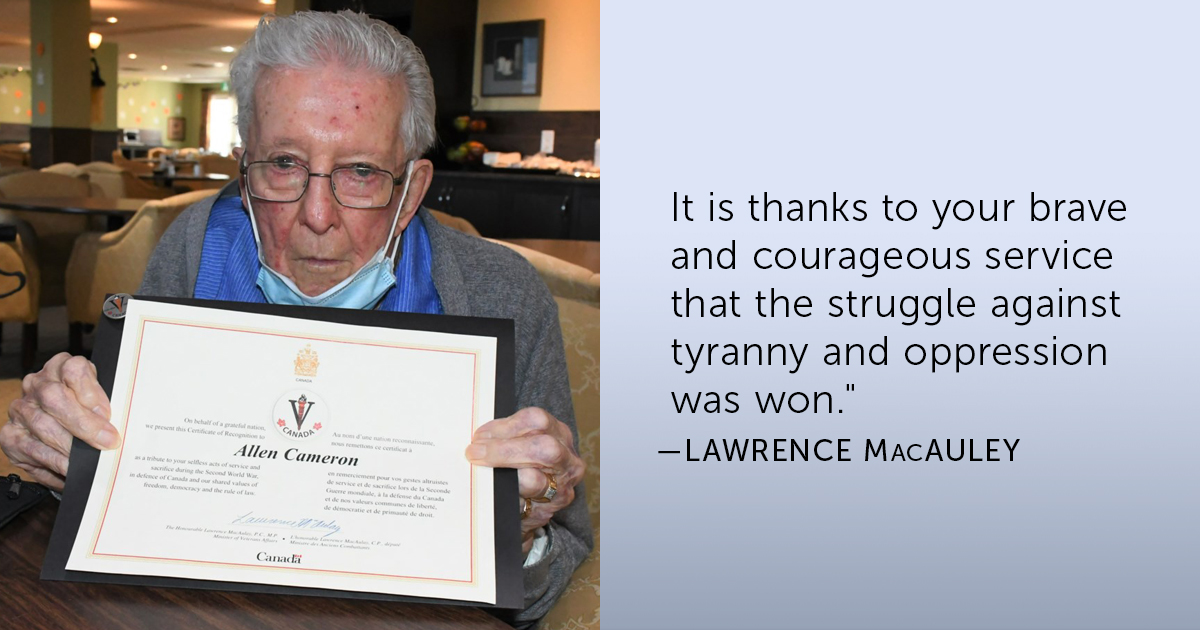This past May, longtime Salvation Army member Allen Cameron was honoured by the Army Navy Air Force Veterans (ANAVETS) and the community of Moose Jaw, Sask., for his service during the Second World War. The November/December issue of Faith & Friends features the story of that happy day. Here, we show why Al was being honoured:
Second World War veteran Allen (Al) Cameron believes the federal government has honoured him with two awards because of an incident in which he was involved while stationed in Italy.
The Department of Veterans Affairs sent Al a certificate of recognition and commemorative lapel pin last year as part of its efforts to thank all servicemen who served during the war.
“I was quite surprised to receive this,” Al says.
In Defence of Canada
“Canadians, like you, selflessly rallied together in extraordinary ways to defend the right of all people to live in peace and freedom. It is thanks to your brave and courageous service that the struggle against tyranny and oppression was won,” said Lawrence MacAuley, minister of Veterans Affairs. “As we mark the 75th anniversary of the end of the Second World War, please know that Canada will never forget your valiant service and dedication to our great country.”
The pin Al received has the “V for victory” symbol and the dates “1939-45”—the years marking the beginning and end of the war—and “2014-2020”—the dates that the federal government marked the 75th anniversary of major milestones that occurred during the war. The certificate, meanwhile, thanks the veteran for his “selfless acts of service and sacrifice during the Second World War, in defence of Canada and our shared values of freedom, democracy and rule of law.”
“Things Had to be Done”
Receiving the two commemorative items allowed Al to jump back 77 years to reflect on what he had done to earn this recognition.
In 1944, Al, then 18, was an airframe maintenance technician with the Royal Canadian Air Force (RCAF). He was stationed 16 kilometres south of the town of Rimini on the east coast of central Italy, where he was responsible for maintaining Spitfire fighter planes.
Al recalled that one day, a small Piper J-3 Cub light aircraft landed on a nearby runway. Out popped an army colonel with one crewman. The officer wanted to fly north to study the front lines in preparation for an upcoming battle.
“The reason he had the crewman was because the aircraft’s propellor had to be started by hand. His crewman was not feeling well, so he wanted to know if the crewman could stay there while he went and did the front-line survey,” Al explains.
“So, he asked if there was anybody who knew how to start this aircraft by swinging the prop by hand. I was the only guy who could do it. I learned it in Moose Jaw, Sask., when I was taking my airframe training course.”
Al started the plane and then joined the colonel on the aerial reconnaissance, repeating the activity the next day. Afterward, the colonel and his crewman returned to base while Al—who thoroughly enjoyed taking part in the spy mission—returned to fixing Spitfires.
“Was I scared over there? You bet your boots I was. And so were the other guys,” he adds. “When I flew in that Piper Cub twice, it didn’t bother me a bit. The war was on, and things had to be done.”
Reprinted from Moose Jaw Express/MooseJawToday.com, October 28, 2021








Leave a Comment